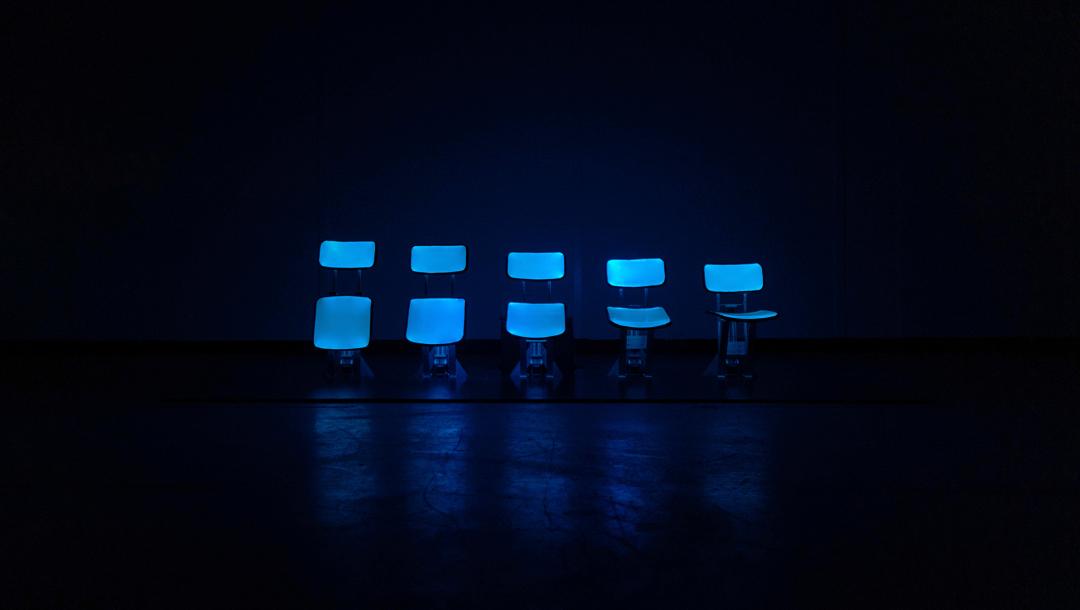The human link
Modern technology enables us to communicate with friends in seconds. We can call, Skype, text or use social media to connect with people from all around the world. But is talking to people face to face becoming a lost art? Connecting online has never been easier, but are we building a wall around us in the physical world? Designers are trying to break down these walls so that we can reconnect with each other.
A conversation with a stranger can have a positive influence on our well-being. So how can design stimulate this social interaction, without invading a person’s privacy? Design studio VOUW will show their answer to this question at DDW19. Their project CHAIRWAVE is a row of chairs in the public space. They are hidden in the wall but fold down when needed. However, the following chair can only be unfolded if it is next to a chair with another person seated on it. As soon as a person sits down, a light wave runs through the seats. So CHAIRWAVE acts as a playful icebreaker, initiating conversations with the people already seated. Through this small gesture, CHAIRWAVE stimulates social interaction between strangers.

Talking to a stranger is easier said than done. We are commonly swayed by the bias of our own pre-assumptions about the person next to us, just from looking at their appearance. Assuming they are ‘not my type’ or not ‘my kind of person’. Another interactive project tries to break down these social walls. Bibliotheek Eindhoven shows Human Library. As the title suggests, it is a library. A traditional library is filled with books. They are doors to unknown worlds and stories. Not the case here. The human library is a collection of interesting people, quirky ones you do not talk to in daily life. In an open 1-on-1 conversation they tell you their life story. Are you ready to listen?
Please move
The digital world has no borders. Without leaving the comfort of our own home, we can travel the world, visit museums or attend performances. The world has been reduced to the dimensions of our screens and we react through the use of our keyboards and cursors. As a response to this, designers are looking for new ways to reconnect our bodies to the physical space they are in.

We spend most of our time in an office. In a typical working week, we spend on average 5 hours and 41 minutes per day sitting at our desks. However, the desk and the office itself are the least inspiring and stimulating surroundings. In recent years designers have become more aware of this problem and see potential for change here. Designer Ingmar Nieuweboer is aiming to change the office space itself. His project The Office Jungle is an experimental office environment combining physical activity and sensual richness in the workplace. It is an interactive environment with geodesic structures, suspended from the walls and ceilings. The line between wall and furniture is blurred, resulting in an engaging space for people to move in freely. They can explore new ways of moving and working. Release your inner ape.

Domestically we also experience distance between ourselves and the space we occupy. The things we surround ourselves with are increasingly industrially made products, devoid of human intervention. Robots are taking over, eliminating human knowledge, skills and experience. At the Rotterdam based design studio Handmade Industrials, Rutger de Regt and Marlies van Putten are attempting to reconnect industrial techniques with human skills. They developed a unique production process using balloons, industrial plastics and their hands. The poetic and brightly coloured objects they make are on show at HOW&WOW by Crafts Council Nederland.
Projects like CHAIRWAVE or the playful objects by Handmade Industrials and Ingmar Nieuweboer create brief moments of shared experience. They trigger collective memories and dialogues. Users reconnect with their physical environment through stimulating playful exploration and social interaction, as well as through active participation. This sense of ownership might be the key to finding new ways of living together and for working on the problems we have in common.
Before we can connect with everything around us, we need to reflect on our own identities. Who are we and where do we come from? Clothes are an important part of expressing our identity. At the presentation New Order of Fashion at Warehouse of Innovation, a group of future fashion thinkers present their new collection. Among them are the just-graduated fashion designers Bodil Ouedraogo (Gerrit Rietveld academy) and Ahmed Serour (London College of Fashion). They are finding new ways to reconnect with their heritage. Coming from different countries and cultures they are interpreting their own individual heritage. This reconnecting with history could deliver solutions for future social problems. Or as Winston Churchill said: “The farther backward you can look, the farther forward you are likely to see.”














